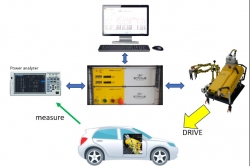 Stähle will unveil its latest advances in accurate and efficient BEV range testing at the expo in October.
Stähle will unveil its latest advances in accurate and efficient BEV range testing at the expo in October.
Identifying the range of battery electric vehicles involves long-duration speed trace tests on a chassis dynamometer. The efficiency and larger battery capacities of modern BEVs have extended the duration of tests, requiring drivers to maintain consistent, precise and repeatable performance for several hours. Post-processing and test protocol generation are complex due to varying regional regulations. Stähle conducts BEV range detection using multiple WLTC and other cycles, combined with steady-state speed phases to deplete the battery to specific state-of-charge (SOC) levels. The challenges for BEV test drivers are similar to those faced by drivers in combustion vehicle emission tests but much longer in duration. Driver performance must meet SAE J2951 standards, focusing on consistent speed tolerance.
BEV range tests end when the vehicle's battery charge is too low to follow the speed trace, requiring a defined termination method. Certification procedures vary by country, increasing the complexity. Development also necessitates measuring electric power conditions at various points in the vehicle powertrain and battery system using power analyzers. The Stähle autopilot system automates EV range and certification test procedures, ensuring precise, repeatable driving 24/7. It integrates with Hioki power analyzers for real-time data collection and generates comprehensive test reports compliant with national regulations. The system replicates human driving styles and integrates with test cell automation systems such as iGEM, MPAS and VETS.
Speak to the team at the show in Novi to find out more.
Booth 5012